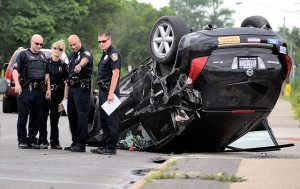There has been some recent controversy on the future of vehicle safety. A report aired earlier this year on NBC 6, in South Florida, asking the question: Are vehicles becoming too safe?
Earlier this year, the National Highway Traffic Safety Administration (NHTSA) released a final ruling on the extended use of laminated auto glass as a safety precaution to help lower the number of deaths and injuries related ejections during rollover accidents. Federal Motor Vehicle Safety Standard (FVMSS) No. 26, “Ejection Mitigation,” “applies to the side windows next to the first three rows of seats, and to a portion of the cargo area behind the first or second rows, in motor vehicles with a gross vehicle weight rating (GVWR) of 4,536 kilogram (kg) or less (10,000 pounds (lb) or less),” according to the standard.
U.S. Transportation Secretary Ray LaHood made a statement about the ruling saying “Safety is our highest priority. This new standard will help save lives and reduce injuries by requiring vehicles to have a safety system that keeps occupants in the vehicle in a rollover crash.”
David Strickland, the administrator of the National Highway Traffic Safety Administration said, “Rollover crashes are the deadliest of all crash types and this is another important step in our efforts to reduce fatalities and serious injuries that result from them,” and “When fully implemented, we believe this standard will prevent on average 373 fatalities and 476 serious injuries every year.”
The standard states that once a rollover crash occurs, vehicle crashworthiness characteristics are crucial in protecting the occupants. Studies show that you have a much better chance of surviving if you are not ejected from the vehicle.
After analyzing data by the NHTSA, it was concluded that adding laminated glass to the side windows would significantly reduce the number of fatalities in rollover crashes.
The standard goes on to discuss the lack of ability to do real world rollover tests. Yet, the final ruling achieved that the benefits were worth the lack of data. While the NBC report focused on the repercussions of installing laminated glass, due to the increased risk of drowning deaths, an article written for the NHTSA and referenced by the Center for Auto Safety show these claims may be unsubstantiated.
In his article, “Drowning Deaths in Motor Vehicle Traffic Accidents,” Rory Austin states, “Very little is known about drowning deaths in the United States as the result of motor vehicle accidents.” Though, Austin does admit that drowning deaths are not studied very closely, and drowning deaths related to vehicle immersion are not reported very accurately. He goes on to explain, that a vehicle being immersed, does not mean that the death was related to drowning, and not the crash itself.
Comparatively, the Center for Auto Safety states in multiple reports that rollover accidents are responsible for an estimated 10,000 deaths annually.
So the ultimate question becomes, would the number of deaths due to drowning during vehicle immersion rise due to the installation of laminate glass? Auto glass safety consultant, Ben Kelley, says not necessarily.
The safety community has long been supportive of using laminated glass on vehicles in places other than just the windshield, where it has long been required. As the NBC report even admits, although there are many negatives, they are far outweighed by the positives.
Kelley went on to offer alternatives to rescue methods, instead of just reducing the safety of glass.
“Perhaps rescue personnel would want to look at developing better tools and techniques for punching through laminated glass in the situations described in the news piece,” says Kelley. “It’s not unlike early concerns about possible airbag disposal hazards in junked cars with undeployed airbags. The scrap industry was fearful of such hazards but eventually developed techniques and guidelines for handling them.”

Leave a Comment
You must be logged in to post a comment.